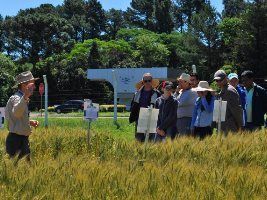
In order to encourage the cultivation of wheat in Brazil, the Federal Government, via law number 470, of August 9, 1937, created the “Wheat Experimental Station”. This establishment, installed in 1939, would be formally inaugurated on November 22, 1940, with the presence of President Getúlio Vargas, becoming known as “Estação Experimental de Passo Fundo”, with headquarters in the town of Engenheiro Luiz Englert (today belonging to the municipality of Sertão). The location, an area of 1700 ha, was chosen because it resembles those preferred by the settlers, who produced wheat in forest lands.
Due to location limitations and, especially, with the displacement of wheat crops from forest areas to field areas, in 1969, this experimental station was transferred to the outskirts of the city of Passo Fundo. Then, inaugurated on April 23, 1972, the “New Passo Fundo Experimental Station” emerged, whose facilities, on the banks of the BR 285 highway, would house, from October 28, 1974, Embrapa’s first decentralized unit: the National Wheat Research Center. The inauguration was attended by the then President of the Republic, Ernesto Geisel. Embrapa Headquarters was formally installed the previous year, on April 26, 1973.
Many curious stories marked the first years of wheat research in the region. One of Embrapa's first researchers, Luiz Ricardo Pereira, says that, still at the Experimental Station, young agricultural technicians and agronomists, aged between 18 and 25 and working on their first job, were faced with a motor vehicle for the first time in their lives: a red rural, an elite car at the time. The result was a mistaken reverse gear that “run over” the plots with experiments. In the report, the loss of the experiment was “the result of adverse weather conditions”.
Another historical fact that influenced investment in wheat research in Brazil can be found in the pages of the biography of journalist Samuel Wainer (Minha Razão de Viver). He was a member of Assis Chateaubriand's associated newspapers. He, at the behest of his boss, went to Rio Grande do Sul to do some interviews to prove that there was no possibility of planting wheat in Brazil. Things that came to his boss's mind. But, after the interviews, the reporter was at an impasse: what he would bring to Chateaubriand was precisely the opposite. It was perfectly possible to grow wheat on southern farms.
Even so, at the time, Senator Chateaubriand (recorded in the book “Chatô: O rei do Brasil”) came to participate with President Jucelino Kubitschek in the 6th National Wheat Festival, in Erechim, RS and, called to give the official speech, showed up is a great enemy of Brazilian wheat production: “Oh Gauchos… wheat has never been more than an accident in the economic life of Brazil and Rio Grande. You have soils that are too rich to devalue them with a poor culture like wheat farming… the widespread acidity of your lands prevents any rational and economical culture…” Chatô rambles, concluding: “Gaúchos! What I want to give you is something similar to what coffee was for São Paulo. Abandon wheat, plant grass, then eat sheep, fill your donkeys with money – I will have more than enough money to import cars, champagne and French women for your pleasure!” The result was that many producers abandoned wheat and started planting black oats, with the recovery of triticulture almost a decade later, based on the results of the research.
Countless stories were part of the consolidation of wheat research in Brazil and reflect the growth of the structure that is Embrapa Trigo today. There are 229 employees, working on a total area of 436 hectares, of which 284 hectares are used as experimental fields and 22 thousand square meters of built area. A structure that encompasses 15 greenhouses, 4 screen blocks totaling approximately 9,000 m² of covered area, 11 laboratories and 1 Active Germplasm Bank (BAG). It has two experimental fields, one next to the research center headquarters in Passo Fundo (RS) and the other in the city of Coxilha (RS).
Birthday Ceremony
The unit's anniversary celebrations took place on 10/28, with a program called “Our harvest”, which included reports from managers, tributes to older employees and a field day.
Ten employees with over 40 years of work at Embrapa were honored: Antônio Faganello, Antônio Ricardo Panizzi, Euclydes Minella, Helena Andrade, Henrique Pereira dos Santos, João Carlos Haas, José Eloir Denardin, Júnior Edison Colla, Raul Alves dos Santos and Sirio Wiethölter .












